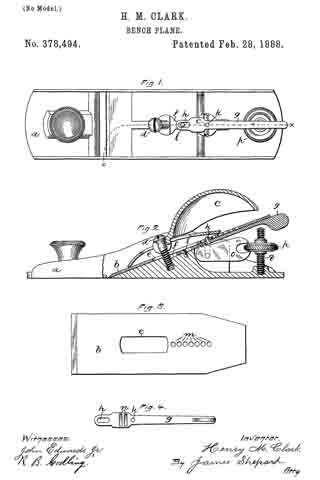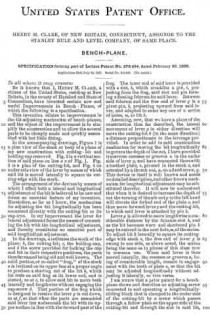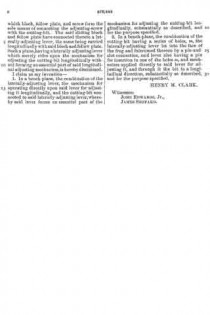
No. 378,494 – Bench-Plane (Henry M. Clark) (1888)
| PLEASE NOTE: The images presented on this page are of low resolution and, as a result, will not print out very well. If you wish to have higher resolution files then you may purchase them for only $2.95 per patent by using the "Buy Now" button below. All purchases are via PayPal. These files have all been cleaned up and digitally enhanced and are therefore suitable for printing, publication or framing. Each zip package contains all the images below (some packages may contain more), and purchased files can be downloaded immediately. |
UNITED STATES PATENT OFFICE.
_________________
HENRY M. CLARK, OF NEW BRITAIN, CONNECTICUT, ASSIGNOR TO
THE STANLEY RULE AND LEVEL COMPANY, OF SAME PLACE.
BENCH-PLANE.
_________________
SPECIFICATION forming part of Letters Patent No. 378,494, dated February 28, 1888.
Application filed July 23, 1887. Serial No. 245,046. (No model.)
_________________
To all whom it may concern:
Be it known that I, HENRY M. CLARK, a citizen of the United States, residing at New Britain, in the county of Hartford and State of Connecticut, have invented certain new and useful Improvements in Bench-Planes, of which the following is a specification.
This invention relates to improvements in the bit-adjusting mechanism of bench-planes; and the object of the improvement is to simplify the construction and to allow the several parts to be cheaply made and quickly assembled with but little fitting.
In the accompanying drawings, Figure 1 is a plan view of the stock or body of a plane of my new construction with cutting-bit and holding-cap removed. Fig. 2 is a vertical section of said plane on line x x of Fig. 1. Fig. 3 is a plan of the cutting-bit, and Fig. 4 an under side view of the lever by means of which said bit is moved laterally to square its cutting-edge with the stock.
The arrangement of the devices by means of which I effect both a lateral and longitudinal adjustment of the bit is believed to be new and forms an essential feature of my invention. Heretofore, so far as I know, the mechanism for adjusting the bit longitudinally has been connected directly with the cutting-bit or its cap-iron. In my improvement the lever for lateral adjustment forms the means of connecting the bit with the longitudinal adjustment, and thereby constitutes an essential part of said longitudinal adjustment.
In the drawings, a indicates the stock of the plane; b, the cutting-bit; c, the holding-cap, and d the screw provided for locking the cap and bit in their respective positions, the parts thus far named being old and well known. The solid portion,or so-called “frog,” of the stock a is inclined on its upper face at a proper angle to produce a shaving cut of the bit b, which bit rests on said frog at its lower end, and is slotted, as at e, to allow said bit to move both laterally and lengthwise without engaging the cap-screw d. That portion of the frog which is designed to receive the lever g is cut down, as at f, so that when the parts are assembled said lever lies underneath the bit with its upper surface in line with the forward part of the frog. The inner end of said lever is provided with a slot, h, which straddles a pin, i, projecting from the frog, said slot and pin forming a floating fulcrum for said lever. Between said fulcrum and the free end of lever g is a pivot-pin, k, projecting upward from said lever, and adapted to enter any one of a series of holes, m, in bit b.
Assuming, now, that we have a plane of the construction thus far described, the lateral movement of lever g in either direction will move the cutting-bit b (in the same direction) a distance proportionate to the leverage provided. In order to add to said construction mechanism for moving the bit longitudinally to govern the depth of the cut, I have provided transverse recesses or grooves n in the under side of lever g, and have connected therewith a toothed plate, o, pivoted in the stock a, and actuated by a thumb-nut, p, on a fixed screw, q. This device in itself is well known and needs no detailed description, and other known mechanism for longitudinal adjustment may be substituted therefor. It will now be understood that when it is desired to increase the depth of out the turning of thumb-nut p to the left hand will elevate the forked end of the plate o, and thus move forward lever g and the cutting-bit, to which said lever is attached by pin k.
Lever g is allowed to move lengthwise a considerable distance by the fulcrum-slot h, and as the bit becomes worn and shortened pin k may be entered in the next hole, m, of the series. To adjust bit b laterally to square its cutting-edge with stock a, the free end of lever g is swung to one side, as above noted, the action being the same as in planes of this class now in common use. When said lever is thus moved laterally, the recesses or grooves n, being of considerable length, remain in engagement with the teeth of plate o, so that the bit may be adjusted longitudinally without adjusting it laterally, or vice versa.
I am aware that a prior patent for a bench-plane shows and describes an adjusting-screw connected to and operating a longitudinally-sliding block that is clamped to the under side of the cutting-bit by a screw which passes through a fellow plate on the upper side of the cutting-bit and through the slot in said bit, which block, fellow plate, and screw form the sole means of connecting the adjusting-screw with the cutting-bit. The said sliding block and fellow plate have connected thereto a laterally-adjusting lever, the same being carried longitudinally with said block and fellow plate. Such a plane, having a laterally-adjusting lever which merely rides upon the mechanism for adjusting the cutting-bit longitudinally without forming an essential part of said longitudinal adjusting mechanism, is hereby disclaimed.
I claim as my invention —
1. In a bench-plane, the combination of the laterally-adjusting lever, the mechanism for operating directly upon said lever for adjusting it longitudinally, and the cutting-bit connected to said laterally-adjusting lever, whereby said lever forms an essential part of the mechanism for adjusting the cutting-bit longitudinally, substantially as described, and for the purpose specified.
2. In a bench-plane, the combination of the cutting-bit having a series of holes, m, the laterally-adjusting lever let into the face of the frog and fulcrumed thereon by a pin-and-slot connection, said lever also having a pin for insertion in one of the holes m, and mechanism applied directly to said lever for adjusting it, and through it the bit in a longitudinal direction, substantially as described, and for the purpose specified.
HENRY M. CLARK.
Witnesses:
JOHN EDWARDS, Jr.,
JAMES SHEPARD.



